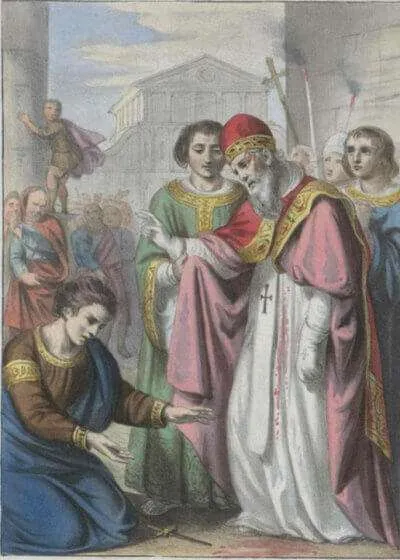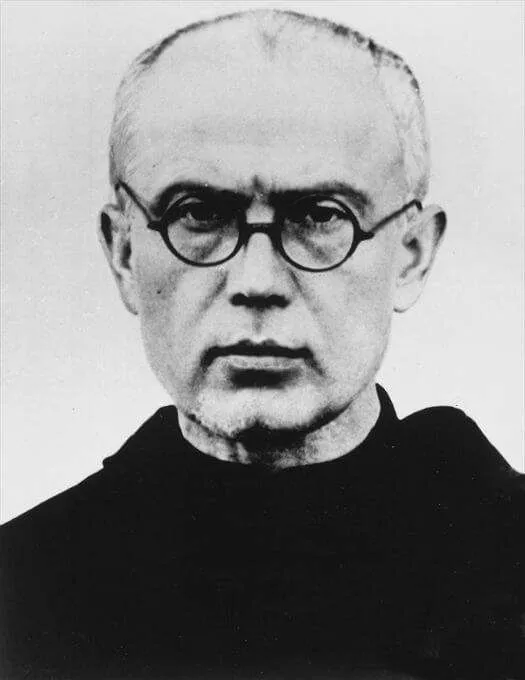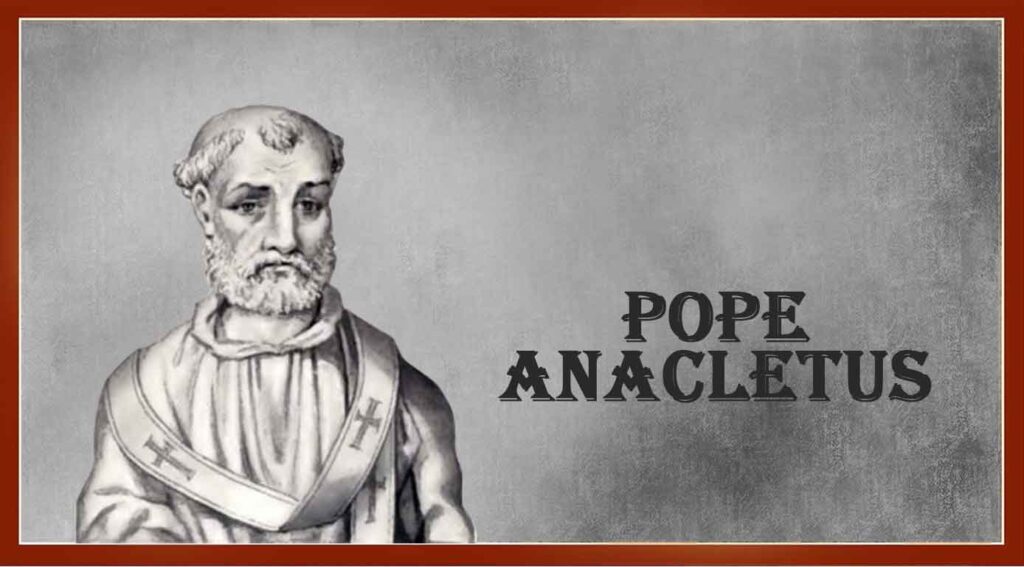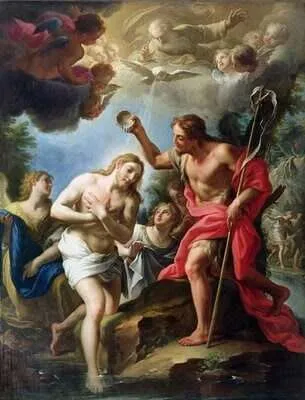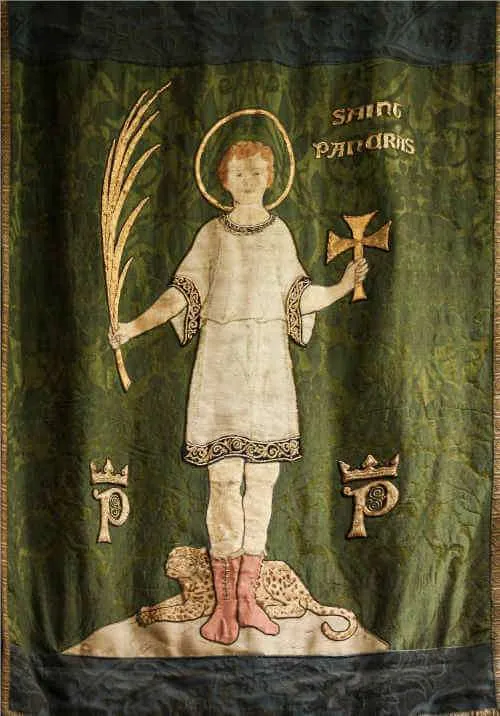c. 1020–1085; Invoked against corruption within the Church; Canonized by Pope Benedict XIII on May 24, 1728
In the eleventh century, civil interference within the Church caused many problems. Simony, the unfortunate practice of buying and selling positions of power within the Church, was rampant. Emperors and other nobility claimed the right to appoint bishops, including the pope, usurping the pope’s universal authority. This abuse is referred to as lay investiture. Additionally, many clerics failed to keep the vow of celibacy, due to the fact that many of them were political appointees rather than men responding to the will of God in faith. It was principally these abuses that today’s saint sought to reform.
Pope Saint Gregory VII was born as Hildebrand in the town of Sovana in modern-day Tuscany, central Italy. At a young age, Hildebrand was sent to Rome to study at Saint Mary’s Monastery on the Aventine Hill, where his uncle was abbot. In 1032, when Hildebrand was about twelve years old, a young man named Theophylactus of Tusculum became pope through a bribe by his father. Theophylactus, who was only twenty years old, took the name Pope Benedict IX. Pope Benedict was immoral and corrupt. In 1044, the faithful ran him out of Rome, and Pope Sylvester III was elected. Benedict IX returned just a year later and retook the papacy by force. Benedict’s second reign lasted less than two months—until he wanted to marry his cousin. His uncle, a holy priest named Gratian, encouraged him to resign and even paid him money to do so. As a result, Gratian was elected pope, taking the name Gregory VI. After being pope for less than two years, Gregory VI was deposed by the Holy Roman Emperor, Henry III, based on accusations that he bought the papacy from his nephew, even though he paid his nephew to leave the papacy to protect the Church.
During much of this turmoil, Hildebrand had lived a monk’s life in a Benedictine abbey of Cluny, France. After Pope Gregory VI’s resignation, the confusion around the papacy continued. In 1049, Bishop Bruno of Toul, France, was chosen pope with the support of the Holy Roman Emperor. However, this saintly bishop refused to accept the papacy until his election was properly confirmed in Rome, by the clergy and people. Bishop Bruno brought Hildebrand with him to Rome, received Roman consent, and became Pope (later, Saint) Leo IX. Pope Leo ordained Hildebrand as a deacon and named him papal administrator and papal legate to Tours, France, and then to Germany. Deacon Hildebrand continued to serve in the papal household during the pontificates of Pope Saint Leo IX, Victor II, Stephen IX, Nicholas II, and Alexander II. He was eventually made Archdeacon of Rome and was considered one of the most influential persons within the Church, second only to the popes he served.
Archdeacon Hildebrand was especially committed to reform of the Church, making him both loved and hated. Hildebrand worked tirelessly to enforce priestly celibacy, establish peace between the Holy Roman Empire and the Byzantines, root out simony, and establish Church law that gave the authority to pick the pope exclusively to the College of Cardinals—not to the civil rulers or nobility. In 1073, around the age of fifty-three, after working closely with five popes, Archdeacon Hildebrand was elected pope himself, taking the name Gregory VII.
The Holy Roman Emperor, Henry IV, was about twenty-two years old when Pope Gregory VII became pope. In 1075, the pope declared twenty-seven clear and concise declarations of papal authority, elevating the authority of the papacy above every civil ruler, including the emperor. This caused quite a conflict among the pope, the emperor, and other nobility. The emperor responded by spreading false rumors that the pope practiced necromancy, hired assassins, and destroyed the Eucharist. By 1076, the emperor and his supporters were calling for the pope’s resignation. Pope Gregory VII not only refused to resign, he went so far as to excommunicate the emperor, forbidding the faithful to obey him. Word spread like wildfire. Support for Henry IV quickly dwindled and the princes declared that if the emperor did not receive absolution from the pope, he would be deposed.
In humiliation, Henry IV walked penitentially south, across the Swiss Alps, in the middle of winter, to meet the pope and beg him for forgiveness and absolution. The snowy conditions were treacherous, but he arrived at a castle in Canossa on January 25, 1077 where the pope was waiting. For three days, Henry stood at the gate shoeless, freezing, humbled, and begging for mercy. Eventually, the pope invited him in, absolved him, and restored him to communion with the Church. The pope then celebrated Mass for him and gave him Holy Communion.
Though Henry humbled himself in appearance, firsthand testimony describes him as distracted and angry. While he was able to regain the support of most of the nobility and princes, he soon turned on the pope again and was excommunicated a second time. War broke out between the papal army and the emperor’s. Eventually, Pope Gregory VII had to flee Rome, and Henry’s army burned the city to the ground. One year later, the pope died in exile in Salerno in 1085. His final words were recorded as, “I have loved what is good and hated what is evil, therefore, I die in exile.”
Pope Saint Gregory VII was a courageous defender of the divine authority God entrusted to the Church and vigorously sought to reclaim that authority. Confronting the Holy Roman Emperor was no small task, but even his decrees of excommunication were meant to reform hearts and reestablish God’s will for the Church. As you ponder the Church today, know that the Church has always been, and most likely always will be, in some need of reform. Do not lose hope if you see a need for reform. Instead, seek to imitate the courage of Pope Saint Gregory VII by firmly resolving to do whatever God asks of you to be an instrument of the reform that is needed, beginning with your own soul.
Source: https://mycatholic.life/saints/saints-of-the-liturgical-year/may-25—saint-gregory-vii-pope/


